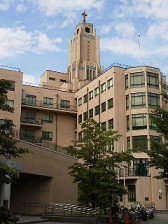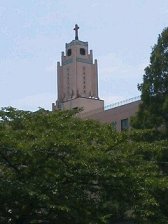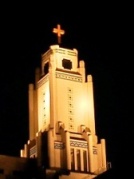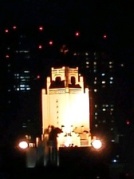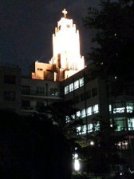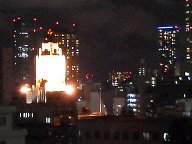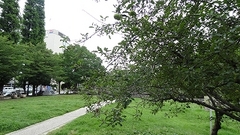If you go straight along Harumi-dori St. at Ginza 4-chome intersection, you will reach Kachidokibashi, completed in 1940, closest to the mouth of the Sumida River via Tsukiji. Cross the bridge and you will see Kachidoki intersection where Harumi-dori St. and Kiyosumi-dori intersect, where Kachidoki Station on the Toei Oedo Line intersect.
If you go further, you will see "Reimei Bridge". It is about 2 km from Ginza 4-chome.
When you cross this bridge, you will see a skyscraper of Harumi Triton completed in 2001 on your left and a park on your right. This park is "Daimeibashi Park" which I would like to introduce.
It's been half a century since I lived near Reimeibashi Park (3-1 Harumi), but after work, I sang on a bench, played with pigeons, and enjoyed lunch. . Now, Arafo's daughter is playing with friends in elementary school and falls into a shallow pond in the park's fountain (?) I had to do it. Trees were thriving on the restrooms and streets of the park, giving a slightly dim impression.
Over time, the overgrowth of trees, the aging of iron fences on parks and sidewalks, the aging of playground equipment in the park, and in recent years, the rapid increase in the population of the Harumi district, the practice ground for soccer, etc. Along with the relocation and merger of "Chibikko Plaza" to Harumi 2-chome, renovation work and maintenance were carried out for four months by the water and green section of Chuo-ku.
And in July, it was completed, and I walked around the park immediately.
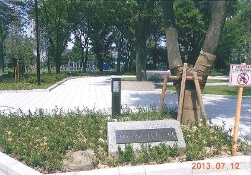
The area is about 6,800 square meters, but with the combined ground of the little child square, the area was doubled, making it a spacious feeling.
Cherry blossoms were added to existing cherry trees, and plums and dogwood were planted. I'm looking forward to the cherry blossoms in full bloom in spring. In addition, although it is currently curing, there is also a lawn open space of 2,000 square meters, and it seems that it can be used for various purposes.
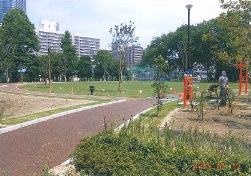
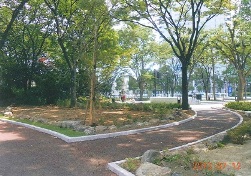
In April 2013, there was a press announcement that the population of Chuo-ku exceeded 130,000, but as of July 1, more than 58,000 people, more than 40%, including Harumi, are here. It is said that you live in the Tsukishima area.
(By the way, about 33,000 people in the Kyobashi area and about 40,000 people in the Nihonbashi area.)
Walking along the streets of Reimeibashi Park is full of vitality.
Compared to when I first lived, there is a sense of every other life.
The urgent priority policy of Chuo-ku in the 1960s was the "Resident Population Recovery Plan (Operation)" in 1997 to stop the population, which was about to fall below 70,000. Compared to about 10 years ago, the number of newborn births was around 500, but last year it exceeded 1,500. Harumi is also full of strollers and feels painfully the dashing vibrancy of young people in the child-rearing generation.
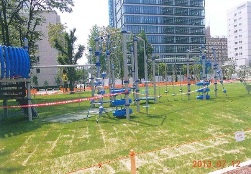
In order to respond to this, many ideas were felt everywhere in Reimeibashi Park.
There were many things that children would be delighted, such as playground equipment for large children, slides, sandboxes with consideration for the surrounding hygiene, and spring playground equipment as facilities.
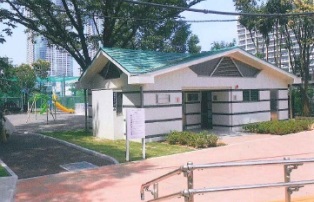
A furnace-shaped bench that adults can relax, a fountain that invites coolness in summer, a solar lighting installed everywhere, a drinking fountain, a healthy playground equipment, a lawn open space, etc. A public toilet was completed.
It was a long-term large maintenance of about 4 months, but it felt very wide and felt that it became a bright park in Harumi, as the name of the local people at the time of 1937 (Showa 12) Was.
The use of neighbors, neighbors, young people, and child-rearing generations can be greatly imagined, but let's make great use of this renovated Reimeibashi Park.
Soon, I'm thinking with my grandchildren!
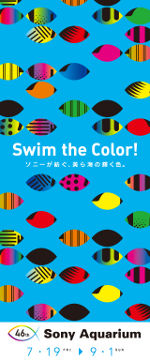 On July 19th, Ginza's summer tradition "Sony Aquarium" came again this year. This is an annual collaboration project with Okinawa "Churaumi Aquarium", and the exhibition period is from July 19 to September 1.
On July 19th, Ginza's summer tradition "Sony Aquarium" came again this year. This is an annual collaboration project with Okinawa "Churaumi Aquarium", and the exhibition period is from July 19 to September 1.